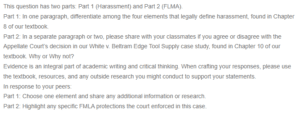Workplace Harassment and FMLA
Elements that Define Harassment
One element that defines harassment is that a victim must have been harassed based on a protected class characteristic. In essence, this means that a complainant must prove that their harassment is because they fall within a protected class, such as LGBTQ, a religious minority group, among others (Walsh, 2019). Another element borders on the severity of the harassment. A victim must prove that the actions of their harasser have cumulatively made it difficult for them to work (Nestian et al., 2015). Notably, a single act and multiple accumulated cases are considered harassment. Also, an action is considered harassment if it is unwelcome and causes unnecessary disruption to job performance. The final element of harassment is liability. One must attribute harassment to the organization or employer for them to lay claim.
The Family and Medical Leave Act (FMLA) Case
Based on the FMLA, the court erred by giving White’s employer a favorable ruling. The court’s decision was based on doctors’ earlier notes that White could return to work. These doctors had not foreseen the possibility that White would need surgery, which took more time than expected. Going by the circumstances surrounding White’s case, the need for surgery was unforeseeable (Walsh, 2019). The doctor’s earlier opinion was based on an elective choice: she could not need surgery if her knee functioned perfectly. Although the FMLA requires an employee to notify their employer about the need for leave, she could not tell if she needed one. Another requirement to qualify for FMLA leave is to provide adequate notice that is practically possible (Kenton, 2020). To that end, Ms White’s leave is justified since she had informed her employer that she had reinjured her knee.
References
Kenton, W. (2020). Introduction to the Family and Medical Leave Act (FMLA). Investopedia. https://www.investopedia.com/terms/f/family-and-medical-leave-act.asp
Nestian, A. S., Tita, S. M., & Arustei, C. C. (2015). Workplace Harassment: A Context Analysis for the Romanian Managers. Annals of the Alexandru Ioan Cuza University – Economics, 62(s1), 75–83. https://doi.org/10.1515/aicue-2015-0038
Walsh, D. J. (2019). Employment law for human resource practice (6th ed.). Cengage.
ORDER A PLAGIARISM-FREE PAPER HERE
We’ll write everything from scratch
Question

Workplace Harassment and FMLA
This question has two parts: Part 1 (Harassment) and Part 2 (FLMA).
Part 1: In one paragraph, differentiate among the four elements that legally define harassment, found in Chapter 8 of our textbook.
Part 2: In a separate paragraph or two, please share with your classmates if you agree or disagree with the Appellate Court’s decision in our White v. Beltram Edge Tool Supply case study, found in Chapter 10 of our textbook. Why or Why not?
Evidence is an integral part of academic writing and critical thinking. When crafting your responses, please use the textbook, resources, and any outside research you might conduct to support your statements.
In response to your peers:
Part 1: Choose one element and share any additional information or research.
Part 2: Highlight any specific FMLA protections the court enforced in this case.


